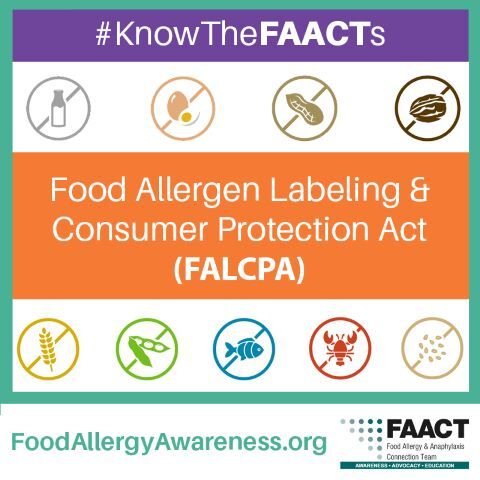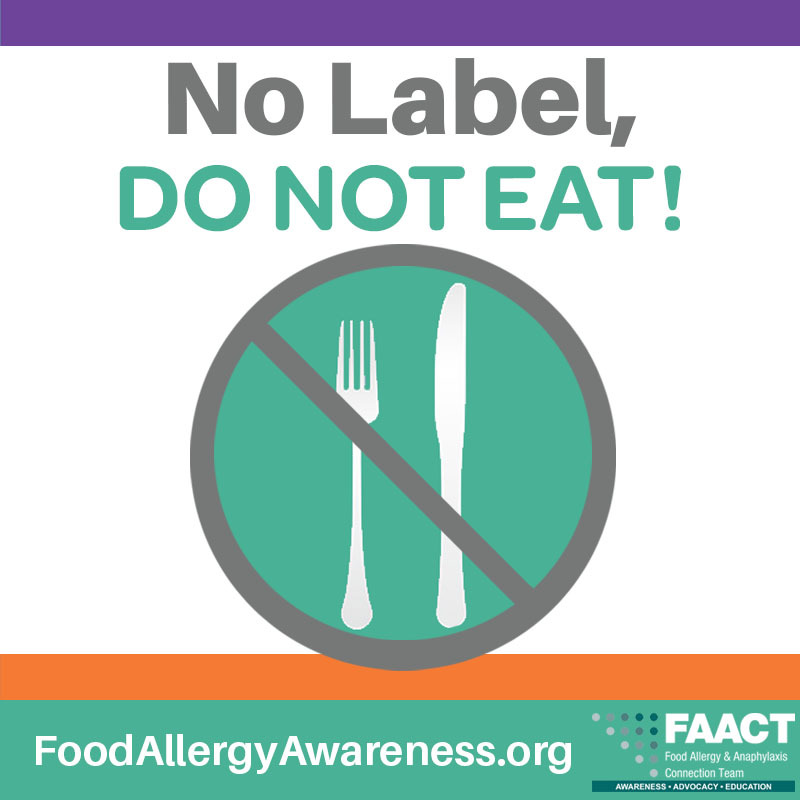Food Labeling

Examples of Allergen Labeling
FALCPA creates a mechanism for companies to obtain an exemption from allergen labeling requirements where: 1) scientific evidence establishes that a food ingredient does not contain allergenic protein, or 2) the FDA determines that the ingredient does not cause an allergic response that poses a risk to human health. There is also a statutory exemption for all highly refined oils, which are generally safe for consumers with food allergy.[6] Companies that do not comply with FALCPA could be subject to civil or criminal penalties under the Federal Food, Drug, and Cosmetic Act. FDA also has the authority to seize packaged food products that are not FALCPA-compliant, along with the authority to request that the food product be recalled by the manufacturer or distributor in the case of an undeclared allergen. Food protection specialists should also be aware that consumers who suspect that an FDA-regulated food product is not FALCPA-compliant can report the product via an FDA consumer complaint center. Consumers can also take it upon themselves to pay a private food laboratory to conduct an allergen analysis of a food product.Although FALCPA has greatly improved the ability of food-allergic individuals and their families to read and interpret food labels, the law does not regulate the use of precautionary allergen statements, sometimes termed supplemental allergen labeling, such as “may contain”, “manufactured in a shared facility”, and “processed on the same equipment”. Consumers often feel as if these types of statements are confusing and misleading, and sometimes criticize companies for using them on food labels. While FDA has been studying the “may contain” issue for a number of years, standardization of the statements, along with guidance for their use, appears unlikely in the near future.
The FDA has control over:
- Packaged foods
- Conventional foods
- Vitamins and dietary supplements
- Infant formula and infant foods
- Medical foods
FALCPA law does not apply to:
- Prescription drugs
- Over-the-counter drugs
- Personal care items such as cosmetics, shampoo, mouthwash, toothpaste or shaving cream.
- Any food product regulated by the USDA, which includes meat, poultry, or certain egg products.
- Any product regulated by the Alcohol, Tobacco Tax and Trade Bureau (ATTB). This includes alcoholic drinks, spirits, beer and tobacco products.
- Any restaurant foods or foods that are placed in a wrapper or container in response to a person's order for that food. This includes street vendors, festival foods, fast food restaurants.
- Kosher labeling
- Pet foods, supplements, and supplies
FSMA
The Food Safety Modernization Act (FSMA) placed greater importance on the control of major food allergens. The new law requires manufacturing facilities to identify and evaluate known or reasonably foreseeable hazards, and develop a written analysis of the hazards. For the purpose of FSMA, a hazard includes biological, chemical, physical, and radiological hazards, natural toxins, pesticides, drug residues, decomposition, parasites, allergens, and unapproved food and color additives, whether these hazards occur naturally, may be unintentionally introduced, or intentionally introduced through an act of terrorism. Along with a written analysis of hazards, facilities are also required to develop preventive control procedures, practices, and processes to significantly minimize or prevent the hazards identified in the written analysis. The law specifies that these preventive control measures may include a food allergen control program.
FASTER Act of 2021
Under the FASTER Act of 2021, sesame is being added as the 9th major food allergen effective January 1, 2023. Until that time, manufacturers do not have to list it as an allergen, although in most cases it must appear in the ingredient statement. An exception is when sesame is part of a natural flavoring or spice. Another exception is when sesame is not in the common or usual name of a food (e.g., tahini, which is made from sesame seeds). In November 2020, to help consumers who are allergic or sensitive to sesame to avoid these products, the FDA issued a draft guidance to encourage manufacturers to voluntarily declare sesame in the ingredient list when it is used as a “flavoring” or “spice” or when the common or usual name (such as tahini) does not specify sesame. The guidance is intended to help protect consumers who are allergic to sesame by encouraging manufacturers to identify all ingredients that contain sesame right now. [7]
Food Program Guidance Under Development
FDA Releases Draft Compliance Policy Guide on Major Food Allergen Labeling and Cross-Contact

Food Labels
When it comes to food allergies, strict avoidance of the food is the only way to prevent an allergic reaction. To ensure foods are safe for your needs, reading food labels is a requirement.
No Label, Do Not Eat!
It is important that children learn from an early age that they must read labels. This practice will help the child to become his or her own advocate and navigate through life safely.
The Food Allergen Labeling and Consumer Protection Act of 2004 requires that foods containing major food allergens be listed in plain English in the ingredient list, in parentheses within the ingredient list, or after the word “contains.” It does not require companies to declare that something “may” or “might” contain, or is “processed in a shared facility” with, any of the major food allergens.
We recommend visiting the FAACT food allergens section of this website to learn more about your particular allergy, hidden ingredients, alternatives, and label reading.
Be aware of “may contain” items on a food label. Research has shown that these products very often contain low levels of the listed allergen. Likewise, be aware that some goods are labeled as “may contain” because a company cannot guarantee the total absence of an allergen, not due to some real concern that the allergen is present in small amounts. Quantification of the exact amount of allergen in these foods is not commercially available.
Studies are ongoing to determine just how “safe” very low levels of allergens are. Many items that are labeled “may contain” do contain parts per million of the allergen (e.g., drops of liquid in an Olympic-sized swimming pool) but other products may contain higher levels. Some individuals may tolerate these low levels better than others. There is ongoing research to better understand the risk that such tiny amounts may pose for people with food allergies, called an allergen threshold. In a few years, the policy of “strict avoidance” may change as medical professionals learn whether patients might be able to tolerate trace exposure and threshold levels are better defined. For now, strict avoidance is the most conservative approach.
Best Practices
- Familiarize yourself on current federal laws and resources that assist food-allergic individuals with product labeling:
- If a product does not have a label, it should not be eaten.
- Read labels each and every time before eating any food product. Ingredients can change over time, or may vary depending upon the size of the product (e.g. jumbo vs snack size).
- Statements advising that products may/might contain or are made in shared facilities with a food allergen are purely voluntary. Most companies do try to be helpful and highlight where there may be a possible risk. However, a product should not be considered “safe” just because it does not list these “maybe’s.”
- Call the company to inquire about how their products are processed, their cleaning methods, and how items are packaged.
- Seeking out products produced in a “dedicated” facility can add an additional level of security to ensure that food is safe.
- Do a search on “allergy friendly” products to generate a list of allergy friendly food companies.
- Carefully check items that are labeled “nut.” The U.S. Food and Drug Administration (FDA) classifies several items as “tree nuts” that are fruits, not tree nuts. These include coconut, lichee nut, shea nut, and Ginko nut. If you have tree nut allergies, talk with your board-certified allergist about whether to avoid these foods.
- Only crustacean shellfish (e.g. crabs, shrimp, lobster, or crayfish) and not mollusks (eg. clams, mussels, scallops, or squid) are required to be labeled on packaged goods.
- The labeling law applies only to foods regulated by the FDA. Meat products, poultry products, and egg products that are regulated by USDA are not required to follow these labeling guidelines. Contact the manufacturer if there are any questions about possible allergens.
- Kosher labeling such as parve (or pareve) do not guarantee they are free of allergen and should not be relied upon in choosing allergy-safe foods.
- Educate teachers, family members, your child, and yourself on the dangers of candies and foods manufactured during the holidays. Often times, candies are manufactured on shared lines that process allergens or may actually contain the allergen itself.
- Pet foods often contain allergens, such as nuts, seeds, seafood, soy, etc. Use caution when feeding pets, and keep pet food out of reach of children with allergies.
- Shampoos, soaps, medications, and other personal care products can contain allergens or items derived from allergens. Use caution when purchasing these products and always check the ingredients prior to use. Many of these products do not pose harm to food-allergic individuals. If this situation arises, discuss this with your physician to see if it is safe to use these products.
- For products labeled non-dairy, check the ingredients list to ensure a derivative, or another form of dairy, is not present.
- Allow children to participate in label reading at the grocery store. This will help build their confidence and help them make informed decisions, as they get older.
Data has indicated that many allergic individuals have unknowingly tolerated very small amounts of allergens that were not labeled (e.g., products that get labeled “may contain” after some time on the market). If this happens, discuss this with your physician if it may be safe to continue to include the food in the diet.
References
[1] Food Allergen Labeling and Consumer Protection Act of 2004. Public Law 108-282, Title II. https://www.fda.gov/food/food-allergensgluten-free-guidance-documents-regulatory-information/food-allergen-labeling-and-consumer-protection-act-2004-falcpa
[2] Food Allergy Canada. Accessed July, 2013 at
https://foodallergycanada.ca/food-allergy-basics/food-allergies-101/what-are-food-allergies/priority-food-allergens/
[3] The Anaphylaxis Campaign (U.K.). Accessed July, 2013 at
http://www.anaphylaxis.org.uk/food-industry/the-law
[4] United States Department of Agriculture. New Food Allergen Labeling Laws (August 2006, revised). Accessed July, 2013 at
https://www.fsis.usda.gov/wps/wcm/connect/dacf9504-f816-44fc-bd2e-9bbd1a0e2380/7230.1.pdf?MOD=AJPERES
[5] Food and Drug Administration. Guidance for Industry: Questions and Answers Regarding Food Allergens, including the Food Allergen Labeling and Consumer Protection Act of 2004 (Edition 4); Final Guidance. Accessed July, 2013 at
http://www.fda.gov/Food/GuidanceRegulation/GuidanceDocumentsRegulatoryInformation/Allergens/ucm059116.htm
[6] Food and Drug Administration. What is the Food Allergen Labeling and Consumer Protection Act of 2004. https://www.fda.gov/industry/fda-basics-industry/what-food-allergen-labeling-and-consumer-protection-act-2004
[7] Food and Drug Administration. Food Labeling and Nutrition. Food Allergies (Sesame). FASTER Act of 2021. https://www.fda.gov/food/food-labeling-nutrition/food-allergies
FDA recently issued a final rule allowing the use of the term “gluten-free” on food labels where the food product contains less than 20 parts-per-million (ppm) of gluten. Questions and Answers on the Gluten-Free Food Labeling Final Rule | FDA

